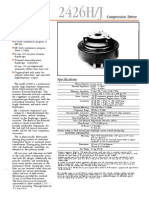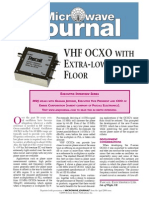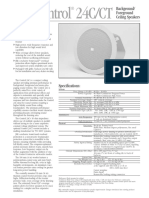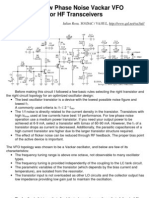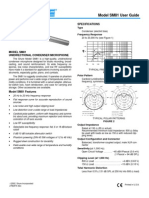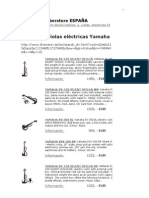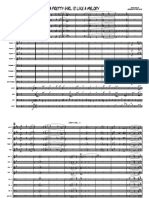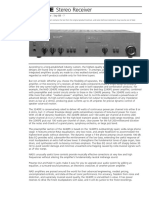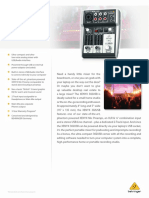JBL Control 226C/T Architectural Specifications: RD RD
JBL Control 226C/T Architectural Specifications: RD RD
Uploaded by
asdfasfqwerqwerCopyright:
Available Formats
JBL Control 226C/T Architectural Specifications: RD RD
JBL Control 226C/T Architectural Specifications: RD RD
Uploaded by
asdfasfqwerqwerOriginal Description:
Original Title
Copyright
Available Formats
Share this document
Did you find this document useful?
Is this content inappropriate?
Copyright:
Available Formats
JBL Control 226C/T Architectural Specifications: RD RD
JBL Control 226C/T Architectural Specifications: RD RD
Uploaded by
asdfasfqwerqwerCopyright:
Available Formats
JBL Control 226C/T
Architectural Specifications
The loudspeaker shall consist of a high-power 165 mm (6.5 in) low frequency (LF) transducer and coaxially-mounted
compression driver (HF) with 25mm (1 in) diameter titanium diaphragm. The components shall be installed in an in-
ceiling-mount ported enclosure with pre-attached backcan of sufficient size as to allow for full low-frequency
performance as stated below.
The LF transducer shall be constructed on a cast aluminum frame, with Kevlar-reinforced cone, 40 mm (1-1/2 in) voice
coil, wound with copper-clad aluminum wire on a high quality T.I.L. voice coil former, for high power handling and
long-term reliability.
The HF driver shall project its sound coaxially through the center of the low frequency transducer, utilizing a flared
throat milled through the LF driver’s pole piece combined with the low frequency cone and the speaker baffle to form a
280 mm (11 in) diameter waveguide having a Progressive Transition contour to achieve pattern control and low
distortion.
The crossover network shall consist of high-slopes for natural-sounding midrange and to achieve the smooth pattern
control in the crossover region. The high-pass filter to the HF driver shall be 3rd order (18 dB per octave) with high
frequency contour circuit for flat frequency response. The low-pass filter to the LF driver shall be 3rd order (18 dB per
octave).
Performance specifications of a typical production unit shall be as follows: The coverage pattern (at 6 dB down from
on-axis level) shall average 120 degrees from 2.5 kHz through 10 kHz with a maximum deviation of +15/-25 degrees at
any one-third octave-band within that frequency range. Power handling when set to the 8 ohm direct setting shall be
150 Watts continuous pink noise power, as tested with a test signal of filtered random noise conforming to international
standard IEC265-5 (shaped pink noise with a peak-to-average ratio of 6 dB) for 2 hours duration. Power handling shall
be 100 Watts for 100 continuous hours duration. Frequency response between 80 Hz and 14 kHz shall be flat to within
± 1 dB at any one-third octave band. Usable frequency response shall extend from 47 Hz to 19 kHz (10 dB below rated
sensitivity, measured in half-space, with no external equalization). Sensitivity measured in half-space (in-ceiling) shall
be at least 90 dB (least mean squared averaged from 80 Hz to 16 kHz). The loudspeaker shall have a continuous sound
level capability of at least 112 dB-SPL average (118 dB-SPL peak) measured at a distance of 1 meter using IEC265-5
pink noise.
The loudspeaker shall be equipped with a low-saturation transformer for use in either 70.7V or 100V distributed-line
sound systems with taps selectable by rotary switch located on the front baffle for easy after-installation adjustment.
Taps shall be nominally 8.5W at 70V (17W at 100V), 17W at 70V (34W at 100V), 34W at 70V (68W at 100V), and
68W at 70V (not used at 100V). The transformer shall have an insertion loss no greater than 1.1 dB at any tap.
Transformer distortion shall be less than 0.2% at any tap (with full 70V sine wave drive signal). The transformer shall
exhibit no more than 5% impedance sag at 40 Hz below its nominal impedance at any tap (measured with full 70V sine
wave drive signal), to protect against excessive current demand from the power amplifier at low frequencies.
The wiring connection shall be via two removable lockable wiring connectors (one for input and one for loop-out to
another loudspeaker) with screw-down terminals to provide secure wiring termination and to allow for pre-wiring of
the connector before the loudspeaker installation. A lockable cover over the terminal compartment shall provide
entrance strain relief for wires as small as 4 mm (0.15 in) diameter and for flex conduit as large as 19 mm ( 3.4 in)
outside diameter.
The loudspeaker shall install via rotating dogears, with dogear lands at two different depths that accommodate ceilings
up to 70 mm (2-3/4 in) thick. The loudspeaker shall be packaged complete with C-ring and tile rails for installation
into both 24” and 600mm suspended ceiling tile systems, as well as hard ceilings. The tile rails shall be of such a design
as to catch on ceiling grids in case of tile failure while not physically contacting the rail during normal operation so as
to minimize transferring of low-frequency rattling to the ceiling grid system. There shall be available optional new-
construction ring and plaster ring for installation in new construction hard ceilings.
The baffle shall be no larger than 330 mm (13 in) in diameter and mounting depth behind the baffle shall extend no
deeper than 246 mm (9.7 in).
The system shall be the JBL Model Control 226C/T., with optional MTC-NC19 new construction bracket or MTC-
19MR plaster ring construction bracket.
070501
You might also like
- JBL Control 5 SpeakersDocument2 pagesJBL Control 5 SpeakersbenshihNo ratings yet
- JBL 4343B SpeakerDocument4 pagesJBL 4343B SpeakerMichael AlinaoNo ratings yet
- Acoustic of Lightweight Timber BuildingsDocument12 pagesAcoustic of Lightweight Timber BuildingsIonFlorentaNo ratings yet
- Milton Babbitt Who Cares If You ListenDocument4 pagesMilton Babbitt Who Cares If You ListenreallyanonymousNo ratings yet
- Control 8xr SpeakerDocument2 pagesControl 8xr SpeakerDane UnkelbachNo ratings yet
- Driver JBLDocument2 pagesDriver JBLVictor HciNo ratings yet
- JBL 2405Document2 pagesJBL 2405feilsch_heringNo ratings yet
- 2426Document2 pages2426dmakaricNo ratings yet
- 460 MM (18 In) Low Frequency Transducer: Professional SeriesDocument2 pages460 MM (18 In) Low Frequency Transducer: Professional SeriescompupirataNo ratings yet
- JBL - Control 1ATDocument2 pagesJBL - Control 1ATmark777markNo ratings yet
- Control 1cDocument2 pagesControl 1cpepeNo ratings yet
- DS1031 ADocument4 pagesDS1031 ATomas VallinNo ratings yet
- JBL Control 89MS SpecSheet 6 1 22Document3 pagesJBL Control 89MS SpecSheet 6 1 22Mohd Fadzlee TokimanNo ratings yet
- EVC-1082-96 8" Speaker 90x60: Technical SpecificationsDocument4 pagesEVC-1082-96 8" Speaker 90x60: Technical SpecificationsmiraclezulaNo ratings yet
- 2241h PDFDocument2 pages2241h PDFjassconsNo ratings yet
- Extended Low Frequency Transducer Key Features: 0221883110 8 Ohm 0221843110 4 OhmDocument2 pagesExtended Low Frequency Transducer Key Features: 0221883110 8 Ohm 0221843110 4 Ohmmarc5532No ratings yet
- Control 8sr 70 100 ManualDocument2 pagesControl 8sr 70 100 ManualRafael Tinajero RaflesNo ratings yet
- Crystal Oscillator Design (MW Journal)Document3 pagesCrystal Oscillator Design (MW Journal)super_lativoNo ratings yet
- Control24Cand24CTSpecSheetReview 1709139709379.pdf Original-Name Control 24C and 24CT Spec Sheet ReviewDocument4 pagesControl24Cand24CTSpecSheetReview 1709139709379.pdf Original-Name Control 24C and 24CT Spec Sheet Reviewhugo americo condori bustamanteNo ratings yet
- Control 28 Spec SheetDocument4 pagesControl 28 Spec Sheetnataly Delgado MontecinosNo ratings yet
- JBL 4408 SpecificationDocument4 pagesJBL 4408 Specification李昆翰No ratings yet
- 2485j ManualDocument2 pages2485j ManualValentina Maldonado PerezNo ratings yet
- DS1032 ADocument4 pagesDS1032 Areading4chNo ratings yet
- Ultra-High Frequency Transducer: SpecificationsDocument4 pagesUltra-High Frequency Transducer: SpecificationsjassconsNo ratings yet
- Outdoor Monitor SpeakerDocument4 pagesOutdoor Monitor Speakercarlos.cordovaNo ratings yet
- JBL Ctrl24C CT.v1 PDFDocument4 pagesJBL Ctrl24C CT.v1 PDFZefRy D'e DSNo ratings yet
- Very Low Phase Noise Vackar VFODocument4 pagesVery Low Phase Noise Vackar VFOShiva Prasad100% (2)
- Potencia Crown D75aDocument2 pagesPotencia Crown D75aJailson Ottoni LimaNo ratings yet
- Sound Advice - CIE Guide To 100v LineDocument3 pagesSound Advice - CIE Guide To 100v Linejanaisha_bai7170No ratings yet
- Simple FM TransmitterDocument6 pagesSimple FM Transmitterxtra4web100% (1)
- Datong AD370 InstructionsDocument5 pagesDatong AD370 Instructionsdaniel21667No ratings yet
- 12-Control 40CS-T Spec SheetDocument2 pages12-Control 40CS-T Spec Sheetarij hhNo ratings yet
- Genelec 1037C and 1038B Tri-Amplified Monitoring Systems Operating ManualDocument6 pagesGenelec 1037C and 1038B Tri-Amplified Monitoring Systems Operating ManualAterSoleNo ratings yet
- 2402H-8 JBLDocument2 pages2402H-8 JBLAntonio Perez PerezNo ratings yet
- General Product Description: 15 Inch Low-Frequency ReproducerDocument2 pagesGeneral Product Description: 15 Inch Low-Frequency ReproducerAngelica EslaitNo ratings yet
- Control 16C/T: Two-Way 6.5" Coaxial Ceiling Loudspeaker Key FeaturesDocument2 pagesControl 16C/T: Two-Way 6.5" Coaxial Ceiling Loudspeaker Key Featuresarij hhNo ratings yet
- CE2000Document2 pagesCE20002015electronicsNo ratings yet
- 8330 ManualDocument4 pages8330 ManualMike GentryNo ratings yet
- Motional Feed Back AmplifierDocument3 pagesMotional Feed Back Amplifierpsinisgalli.mahindracomvivaNo ratings yet
- Control 18C/T: Two-Way 8" Coaxial Ceiling Loudspeaker Key FeaturesDocument2 pagesControl 18C/T: Two-Way 8" Coaxial Ceiling Loudspeaker Key Featuresarij hhNo ratings yet
- XRC33F16CDDocument2 pagesXRC33F16CDWeeAllanNo ratings yet
- Atlas180 ManualDocument24 pagesAtlas180 ManualalrleitaoNo ratings yet
- Peralatan PemancarDocument23 pagesPeralatan PemancarGhufranaka Aldrien NanangNo ratings yet
- 18 LW 1400Document2 pages18 LW 1400Andrei ZamfirNo ratings yet
- JBL - Ctrl14C - T v1 PDFDocument2 pagesJBL - Ctrl14C - T v1 PDFashielanieNo ratings yet
- Control 62P: Ultra-Compact Mid-High Satellite Pendant SpeakerDocument2 pagesControl 62P: Ultra-Compact Mid-High Satellite Pendant SpeakerJimit ShahNo ratings yet
- Heathkit O-11 5 Extra Duty OscilloscopeDocument2 pagesHeathkit O-11 5 Extra Duty OscilloscopeTodoresc NicolaeNo ratings yet
- Control 19CS and 19CST Spec Sheet ReviewDocument3 pagesControl 19CS and 19CST Spec Sheet ReviewEvelio PérezNo ratings yet
- Nexo Ps15-r2 DatasheetDocument2 pagesNexo Ps15-r2 DatasheetChing Tsz Pan0% (1)
- MTH-1 Engineering Data SheetDocument4 pagesMTH-1 Engineering Data SheetAugusto KozukiNo ratings yet
- SM 81Document20 pagesSM 814_vientos100% (1)
- 4411 Studio MonitorDocument4 pages4411 Studio MonitorabraxastributetosantanaNo ratings yet
- Review Sa2000 Amp 1Document1 pageReview Sa2000 Amp 1Gary CaireNo ratings yet
- LC2 PC30G6 8 Data Sheet enUS 1926546571 PDFDocument4 pagesLC2 PC30G6 8 Data Sheet enUS 1926546571 PDFkwokchunsang6549No ratings yet
- A Shortened 7 MHZ DipoleDocument46 pagesA Shortened 7 MHZ Dipoleadel agustiNo ratings yet
- DAS Factor 5 SpecsDocument2 pagesDAS Factor 5 SpecsJeremy.S.BloomNo ratings yet
- JBL 4412 Studio Monitor ManualDocument4 pagesJBL 4412 Studio Monitor ManualWilliam StricklerNo ratings yet
- Control 25-1L: FeaturesDocument3 pagesControl 25-1L: FeaturesVíctor Manuel GTNo ratings yet
- A Guide to Vintage Audio Equipment for the Hobbyist and AudiophileFrom EverandA Guide to Vintage Audio Equipment for the Hobbyist and AudiophileNo ratings yet
- Spydus - Join OnlineDocument1 pageSpydus - Join OnlineasdfasfqwerqwerNo ratings yet
- 2-Way Full-Range Loudspeaker With 1 X 8" LF: SystemDocument2 pages2-Way Full-Range Loudspeaker With 1 X 8" LF: SystemasdfasfqwerqwerNo ratings yet
- 2-Way Full-Range Loudspeaker With 1 X 12" LF Key Features:: SystemDocument2 pages2-Way Full-Range Loudspeaker With 1 X 12" LF Key Features:: SystemasdfasfqwerqwerNo ratings yet
- 2-Way Full-Range Loudspeaker System With 1 X 15" LFDocument2 pages2-Way Full-Range Loudspeaker System With 1 X 15" LFasdfasfqwerqwerNo ratings yet
- CARA Test-CD: Tracks 1..28 (70 Sec/track) Track Frequency Track Frequency Track Frequency Track Frequency Track FrequencyDocument1 pageCARA Test-CD: Tracks 1..28 (70 Sec/track) Track Frequency Track Frequency Track Frequency Track Frequency Track FrequencyasdfasfqwerqwerNo ratings yet
- Violines y Violas Eléctricas Yamaha: Thomann Cyberstore ESPAÑADocument4 pagesViolines y Violas Eléctricas Yamaha: Thomann Cyberstore ESPAÑALes Antonio Muñoz CalderonNo ratings yet
- Breathing.: Suizen Is A Zen Buddhist Practice of Meditation From Blowing AirDocument2 pagesBreathing.: Suizen Is A Zen Buddhist Practice of Meditation From Blowing AirEvan SanchezNo ratings yet
- Complete Classical CollectionDocument39 pagesComplete Classical CollectionsampionsremaNo ratings yet
- 50 Minor II V I Bebop Lines Single Key Edition by JK ChangDocument119 pages50 Minor II V I Bebop Lines Single Key Edition by JK ChangKees Haak100% (6)
- User Manual: Water Leak DetectorDocument16 pagesUser Manual: Water Leak DetectorAndrei NastutaNo ratings yet
- 01 Bailey 1972 Transmission Line Loudspeaker EnclosureDocument3 pages01 Bailey 1972 Transmission Line Loudspeaker EnclosureyycremotestartNo ratings yet
- 10 Accuracy of Prediction Methods For Sound Transmission LossDocument8 pages10 Accuracy of Prediction Methods For Sound Transmission LossJuan Ambrosio MartinezNo ratings yet
- Major ProjectDocument84 pagesMajor ProjectShubam GaonkarNo ratings yet
- Phet Lab Light and Sound WavesDocument2 pagesPhet Lab Light and Sound Wavesapi-259781257No ratings yet
- A Pretty GirlDocument5 pagesA Pretty GirlAnonymous v5arxM8yHNo ratings yet
- NAD 3240PE Integrated AmplifierDocument2 pagesNAD 3240PE Integrated Amplifierpascalb41100% (1)
- Organizing Principles/Techniques That Creates Musical Form RepetitionDocument45 pagesOrganizing Principles/Techniques That Creates Musical Form RepetitionMitylene BerdonarNo ratings yet
- Behringer 302usb Apayooo PDFDocument8 pagesBehringer 302usb Apayooo PDFRizki MashudiNo ratings yet
- SWS 10Document2 pagesSWS 10daithedayNo ratings yet
- Pro Mixer DJX USB: User ManualDocument11 pagesPro Mixer DJX USB: User ManualBhushan PanditNo ratings yet
- Professors Academy Mian Channu: Roll NumberDocument2 pagesProfessors Academy Mian Channu: Roll NumberIrfanAliAfridiNo ratings yet
- GTRJimmy413 GR-55 Doc 110924Document10 pagesGTRJimmy413 GR-55 Doc 110924Cristiano TiagoNo ratings yet
- NT Acou 053 - Rooms - Reverberation Time - Nordtest MethodDocument7 pagesNT Acou 053 - Rooms - Reverberation Time - Nordtest MethodEMA54No ratings yet
- AP Music Theory SyllabusDocument4 pagesAP Music Theory SyllabusIoanaPopescuNo ratings yet
- AirmanDocument2 pagesAirmanMuhammad Arqam Al AjamNo ratings yet
- Exploring and Evaluating The Effects of Video Game Audio's Musicality, Implementation and Spatial Playback On Player ImmersionDocument37 pagesExploring and Evaluating The Effects of Video Game Audio's Musicality, Implementation and Spatial Playback On Player ImmersionAndrew IsaiasNo ratings yet
- Mus 412 Repertory ProjectDocument61 pagesMus 412 Repertory Projectapi-510874732No ratings yet
- Speak ResDocument6 pagesSpeak ResDeepak Avarani100% (1)
- Chino Toledo - List of Other Works PDFDocument10 pagesChino Toledo - List of Other Works PDFsergNo ratings yet
- Solution Manual For Acoustics in Hearing Speech and Language Sciences An Introduction LLV 0132897083Document6 pagesSolution Manual For Acoustics in Hearing Speech and Language Sciences An Introduction LLV 0132897083Scarlett Bryant100% (39)
- Draft Quote Ganjar Pranowo MonjuDocument1 pageDraft Quote Ganjar Pranowo MonjuDPD PARTAI HANURA JAWA BARATNo ratings yet
- Onkyo E900M Leaflet BlackDocument2 pagesOnkyo E900M Leaflet Blackmttw010No ratings yet
- Bailey's 5th Ed (2014) - Ossicular RekonstruksiDocument12 pagesBailey's 5th Ed (2014) - Ossicular RekonstruksiMei Risanti SiraitNo ratings yet








